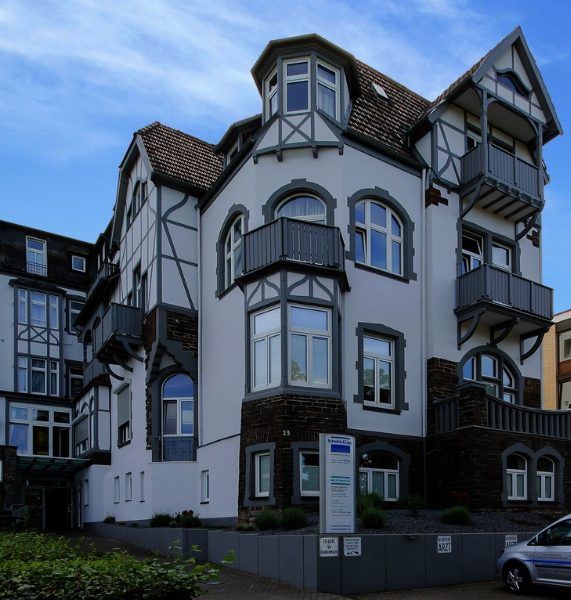VENEN-CLINIC

Hochstr. 23
53474 Bad Neuenahr-Ahrweiler
Phone:
02641-80090
Fax:
02641-8009-99
Mail:
ed.cinilc-nenev@ofni
- Number of beds: 36
- Number of specialist departments: 2
- Number of inpatient cases: 1.456
- Number of outpatient cases: 3.786
- Hospital owners: Fa. phlebo-med GmbH
- Type of provider: privat
Further information
| Bezeichnung | |
| Teilnahme externe Qualitätssicherung | does not apply |
- Quality of participation in the Disease Management Programme (DMP)
No participation
- Implementation of the minimum quantity agreement
No participation
- Implementation of resolutions of the Federal Joint Committee on quality assurance (G-BA)
No participation
- Clarifying chat completed: no
- Clarifying chat not completed: no
- No participation in clarifying chat: no
- Notification of non-fulfilment of nursing care not made: no
| Number | Group |
|---|---|
| 12 | Medical specialists (m/f) , psychological psychotherapists (m/f) and child and adolescent psychotherapists (m/f) who are subject to the obligation to undergo further training* |
| 0 | Number of medical specialists (m/f) from no. 1 who have completed a five-year period of further training and are therefore subject to the obligation to provide evidence |
| 0 | Number of those persons from no. 2 who have provided proof of further training according to Article 3 of the G-BA regulations |
According to Section 4 (2) of the Quality Management Guideline, facilities must provide for the prevention of and intervention in cases of violence and abuse as part of their internal quality management. The aim is to prevent, recognise and respond appropriately to abuse and violence, particularly against vulnerable patient groups such as children and adolescents or people in need of help, and also to prevent it within the facility. The respective procedure is aligned with the size of the facility, the range of services and the patients in order to define customised solutions for sensitising the teams as well as other suitable preventative and interventional measures. These may include information materials, contact addresses, training/education, codes of conduct, recommendations for action/intervention plans or comprehensive protection concepts.
- Is a protection concept in place? No
- No care for children and young people
- Functional areas: Ärztliche Leitung, Abtlg. Gefäßchirurgie, Abtlg. Anästhesie, Pflegedienst- sowie Anästhesie- und OP-Leitung, Küche, Verwaltung, Krankenhausapotheke, Krankenhaushygiene
- Conference frequency: quartalsweise
Training of employees on AMTS related topics
Possibility of electronic prescription i.e. structured entry of active substances (or name of the preparation), form, dose, dose frequency (e.g. in the HIS, in prescription software)
Provision of one or more electronic drug information systems (e.g. Lauer-Taxe®, ifap klinikCenter®, Gelbe Liste®, Fachinfo-Service®)
- Anwendung von gebrauchsfertigen Arzneimitteln bzw. Zubereitungen
- s. Hinweis unter A-12.5
- Admission to hospital, including anamnesis
; Instruments and measures are presented for determining the old medication (drug history), the subsequent clinical assessment and the switch to the medication available in the hospital (house list), as well as for documenting both the patient's original medication and that for hospital treatment adapted medication.
- Medication process in the hospital
In this context, the following sub-processes are assumed as examples: drug history - prescription - patient information - drug delivery - drug use - documentation - therapy monitoring - result assessment. Instruments and measures for safe medication prescription can be presented, e.g. B. in terms of readability, clarity and completeness of the documentation, but also in terms of area of application, effectiveness, benefit-risk ratio, tolerability (including potential contraindications, interactions, etc.) and resource considerations. Information can also be provided to support reliable medication ordering, delivery and use or administration.
- Discharge
In particular, the measures taken by hospitals can be presented to ensure that information on drug therapy is structured and passed on to doctors and physicians providing further treatment, as well as the appropriate provision of patients with drug information, medication plans and medications. Drug prescriptions are made.
- Hospital staff
- Number of pharmacists: 1
- Explanations: Beratung und Gestellung im Rahmen des bestehenden Versorgungsvertrages mit der ext. Krankenhausapotheke (s. Pkt. A-12.5)
Dr. med. Peter-Matthias Baier
Chefarzt
Hochstr. 23
53474 Bad Neuenahr-Ahrweiler
Phone:
02641
-8009-0
Mail:
ed.cinilc-nenev@ofni
Betriebswirt (B.A.) Dino Nogarole
Verwaltungsleitung
Hochstr. 23
53474 Bad Neuenahr-Ahrweiler
Phone:
02641
-8009-0
Mail:
ed.cinilc-nenev@ofni
Dr. med. Peter-Matthias Baier
Chefarzt
Hochstr. 23
53474 Bad Neuenahr-Ahrweiler
Phone:
02641
-8009-0
Mail:
ed.cinilc-nenev@ofni
Dr. med. Peter-Matthias Baier
Chefarzt, Hygienebeauftragter Arzt der Einrichtung
Hochstr. 23
53474 Bad Neuenahr-Ahrweiler
Phone:
02641
-8009-0
Mail:
ed.cinilc-nenev@ofni
Betriebswirt (B.A.) Dino Nogarole
Verwaltungsleitung
Hochstr. 23
53474 Bad Neuenahr-Ahrweiler
Phone:
02641
-8009-0
Mail:
ed.cinilc-nenev@ofni
53474 Bad Neuenahr-Ahrweiler
Phone:
02641-80090
Fax:
02641-8009-99
Mail:
ed.cinilc-nenev@ofni
Anke Paasche
Pflegedienstleitung
Hochstr. 23
53474 Bad Neuenahr-Ahrweiler
Phone:
02641
-8009-0
Mail:
ed.cinilc-nenev@ofni
Betriebswirt B.A. Dino Nogarole
Verwaltungsleitung
Hochstr. 23
53474 Bad Neuenahr-Ahrweiler
Phone:
02641
-8009-0
Mail:
ed.cinilc-nenev@ofni
Dr. med. Peter-Matthias Baier
Chefarzt, Geschäftsführer
Hochstr. 23
53474 Bad Neuenahr-Ahrweiler
Phone:
02641
-8009-0
Mail:
ed.cinilc-nenev@ofni
Dr. med. Peter-Matthias Baier
Chefarzt, Geschäftsführer
Hochstr. 23
53474 Bad Neuenahr-Ahrweiler
Phone:
02641
-8009-0
Mail:
ed.cinilc-nenev@ofni
IK: 260711373
Location number: 772129000
